Related Research Articles

The Gallipoli peninsula is located in the southern part of East Thrace, the European part of Turkey, with the Aegean Sea to the west and the Dardanelles strait to the east.

Anzac Day is a national day of remembrance in Australia, New Zealand and Tonga that broadly commemorates all Australians and New Zealanders "who served and died in all wars, conflicts, and peacekeeping operations" and "the contribution and suffering of all those who have served". Observed on 25 April each year, Anzac Day was originally devised to honour the members of the Australian and New Zealand Army Corps (ANZAC) who served in the Gallipoli campaign, their first engagement in the First World War (1914–1918).

The Gallipoli campaign, the Dardanelles campaign, the Defence of Gallipoli or the Battle of Gallipoli was a military campaign in the First World War on the Gallipoli peninsula from 19 February 1915 to 9 January 1916. The Entente powers, Britain, France and the Russian Empire, sought to weaken the Ottoman Empire, one of the Central Powers, by taking control of the Turkish straits. This would expose the Ottoman capital at Constantinople to bombardment by Entente battleships and cut it off from the Asian part of the empire. With the Ottoman Empire defeated, the Suez Canal would be safe and the Bosphorus and Dardanelles straits would be open to Entente supplies to the Black Sea and warm-water ports in Russia.

The New Zealand and Australian Division was a composite army division raised for service in the First World War under the command of Major General Alexander Godley. Consisting of several mounted and standard infantry brigades from both New Zealand and Australia, it served in the Gallipoli Campaign between April and December 1915.
The Battle of Sari Bair, also known as the August Offensive, represented the final attempt made by the British in August 1915 to seize control of the Gallipoli peninsula from the Ottoman Empire during the First World War.

HMAS AE2 was an E-class submarine of the Royal Australian Navy (RAN). One of two submarines ordered for the fledgling navy, AE2 was built by Vickers Armstrong in England and was commissioned into the RAN in 1914. Together with her sister submarine, HMAS AE1, the boat then sailed to Australia in what was, at the time, the longest voyage ever undertaken by a submarine.

The landing at Anzac Cove on Sunday, 25 April 1915, also known as the landing at Gaba Tepe and, to the Turks, as the Arıburnu Battle, was part of the amphibious invasion of the Gallipoli Peninsula by the forces of the British Empire, which began the land phase of the Gallipoli campaign of the First World War.
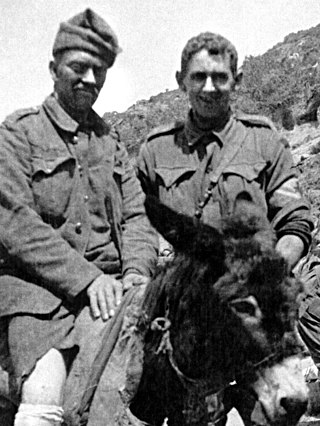
John Kirkpatrick, commonly known as John Simpson, was a stretcher bearer with the 3rd Australian Field Ambulance during the Gallipoli campaign – the Allied attempt to capture Constantinople, capital of the Ottoman Empire, during the First World War.
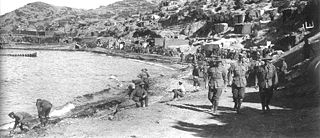
Anzac Cove is a small cove on the Gallipoli peninsula in Turkey. It became famous as the site of World War I landing of the ANZACs on 25 April 1915. The cove is 600 metres (2,000 ft) long, bounded by the headlands of Arıburnu to the north and Little Arıburnu, known as Hell Spit, to the south. Following the landing at Anzac Cove, the beach became the main base for the Australian and New Zealand troops for the eight months of the Gallipoli campaign.

The Australian and New Zealand Army Corps (ANZAC) was originally a First World War army corps of the Mediterranean Expeditionary Force. It was formed in Egypt in December 1914, and operated during the Gallipoli campaign. General William Birdwood commanded the corps, which primarily consisted of troops from the First Australian Imperial Force and 1st New Zealand Expeditionary Force, although there were also British and Indian units attached at times throughout the campaign. The corps disbanded in 1916, following the Allied evacuation of the Gallipoli peninsula and the formation of I ANZAC Corps and II ANZAC Corps. The corps was re-established, briefly, in the Second World War during the Battle of Greece in 1941. The term 'ANZAC' has been used since for joint Australian–New Zealand units of different sizes.
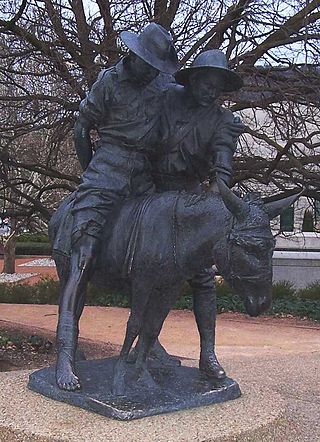
The Anzac spirit or Anzac legend is a concept which suggests that Australian and New Zealand soldiers possess shared characteristics, specifically the qualities those soldiers allegedly exemplified on the battlefields of World War I. These perceived qualities include endurance, courage, ingenuity, good humour, larrikinism, and mateship. According to this concept, the soldiers are perceived to have been innocent and fit, stoical and laconic, irreverent in the face of authority, naturally egalitarian, and disdainful of British class differences.

Ellis Ashmead-Bartlett was an English war correspondent during the First World War. Through his reporting of the Battle of Gallipoli, Ashmead-Bartlett was instrumental in the birth of the Anzac legend which still dominates military history in Australia and New Zealand. Through his outspoken criticism of the conduct of the campaign, he was instrumental in bringing about the dismissal of the British commander-in-chief, Sir Ian Hamilton – an event that led to the evacuation of British forces from the Gallipoli peninsula.
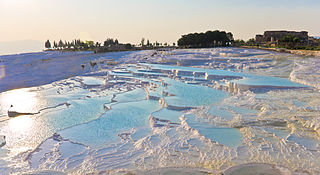
Tourism in Turkey is focused largely on a variety of historical sites, and on seaside resorts along its Aegean and Mediterranean Sea coasts. Turkey has also become a popular destination for culture, spa, and health care. Since 2021, Turkey is the fourth most visited country in the world.
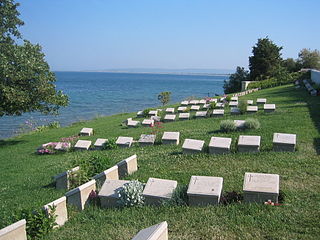
Beach Cemetery is a small Commonwealth War Graves Commission cemetery containing the remains of allied troops who died during the Battle of Gallipoli. It is located at Hell Spit, at the southern end of Anzac Cove on the Gallipoli Peninsula.

Foreign relations exist between the Commonwealth of Australia and the Republic of Turkey. Diplomatic relations between the two countries were established in 1967. Australia has had an embassy in Ankara since 1968, a consulate-general in Istanbul and a consulate in Çanakkale. Turkey has had an embassy in Canberra since 1967 and two consulates-general in Melbourne and Sydney.
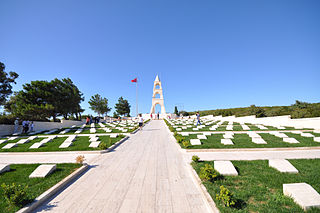
The 57th Infantry Regiment or simply 57th Regiment was a regiment of the Ottoman Army during World War I. In response to the landing at Anzac Cove of Australian and New Zealand forces on 25 April 1915 the 57th Regiment counterattacked, slowed the Allied advance and lost about half of its personnel. Mustafa Kemal later noted that the 57th Regiment was "a famous regiment this, because it was completely wiped out".

Hüseyin Avni Bey was the commander of the 57th Infantry Regiment of the Ottoman Army at the Battle of Gallipoli during which he led a counterattack that successfully stabilized the right flank of the Ottoman defences on the 25 April 1915.

The third attack on Anzac Cove was an engagement during the Gallipoli Campaign of the First World War. The attack was conducted by the forces of the Ottoman Turkish Empire, against the forces of the British Empire defending the cove.

The Gallipoli Peninsula Historical Site covers over 33,000 hectares in Gallipoli, Turkey. The park was established in 1973 by the Turkish government and is included in the United Nations list of National Parks and Protected Areas. Gallipoli Peninsula Historical Site is home to memorials, graveyards, and commemorations of events that took place on the peninsula since the First World War.

Atatürk Channel, also known as Atatürk Entrance is a water channel named after Mustafa Kemal Atatürk and located at King George Sound leading to Princess Royal Harbour in Albany on the south coast of Western Australia.
References
- ↑ "Numbers of Australians Overseas in 2001 by Region - Southern Cross Group" (PDF). www.southern-cross-group.org. Archived from the original (PDF) on 20 July 2008. Retrieved 14 June 2010.
- 1 2 3 4 Australian War Memorial (2021). "Gallipoli". www.awm.gov.au. Archived from the original on 27 January 2018.
- 1 2 "Anzac Day | Army.gov.au". www.army.gov.au. Archived from the original on 2 May 2020. Retrieved 6 December 2021.
- 1 2 3 Department of Veterans' Affairs (2021). "Gallipoli Campaign 1915". anzacportal.dva.gov.au. Archived from the original on 15 March 2020.
- 1 2 National Museum of Australia (2021). "Gallipoli landing". www.nma.gov.au. Archived from the original on 14 November 2018.
- ↑ Slade, Peter (October 2003). "Gallipoli thanatourism". Annals of Tourism Research. 30 (4): 779–794. doi:10.1016/S0160-7383(03)00025-2.
- ↑ McDonald, Matt (September 2017). "Remembering Gallipoli: Anzac, the Great War and Australian Memory Politics". Australian Journal of Politics & History. 63 (3): 406–418. doi:10.1111/ajph.12372.
- 1 2 3 4 5 6 Buchanan, Kelly (24 April 2015). "Centenary of the Landing at Anzac Cove During World War I". Library of Congress. Archived from the original on 7 September 2015.
- ↑ Simpson, Catherine (November 2010). "From Ruthless Foe to National Friend: Turkey, Gallipoli and Australian Nationalism". Media International Australia. 137 (1): 58–66. doi:10.1177/1329878X1013700107. S2CID 146837190.
- 1 2 Ergil, Leyla (9 April 2019). "How to take part in Anzac Day in Turkey". Daily Sabah. Archived from the original on 9 April 2019.
- ↑ "Anzac Day, Gallipoli". Turkey Travel Planner. Archived from the original on 22 November 2006.
- 1 2 "April 24th, 1915 Gallipoli Centenary: Turkey, Britain, Australia and New Zealand mark Anzac Day at Gallipoli". Turkish Coalition of America. Archived from the original on 8 July 2016.
- ↑ "Anzac Day: Gallipoli centenary services held from Europe to New Zealand". The Guardian. 25 April 2015. Archived from the original on 25 April 2015.
- ↑ "Australian Embassy Turkey, Azerbaijan and Georgia". Archived from the original on 13 June 2007.
- ↑ "Ambassador to Turkey". www.foreignminister.gov.au. 6 October 2021. Archived from the original on 15 October 2021.
- 1 2 3 "Australia in Turkey". Australian Design Review. 24 April 2015. Archived from the original on 4 January 2022.
- 1 2 3 4 5 "Celebrating Australian culture in Turkey". www.foreignminister.gov.au. 6 November 2014. Archived from the original on 6 April 2020.
- 1 2 3 4 5 6 Dark, Gülşah (14 September 2015). "Celebrating Australian culture year in Turkey continues at full speed". Daily Sabah. Archived from the original on 27 September 2015.
- 1 2 "Travel Restrictions Entering Turkey from Australia". Airheart. Archived from the original on 4 January 2022.
- 1 2 3 "New Turkish Tourist Visa Regulation". Australian Embassy Turkey, Azerbaijan and Georgia. Archived from the original on 27 February 2012.